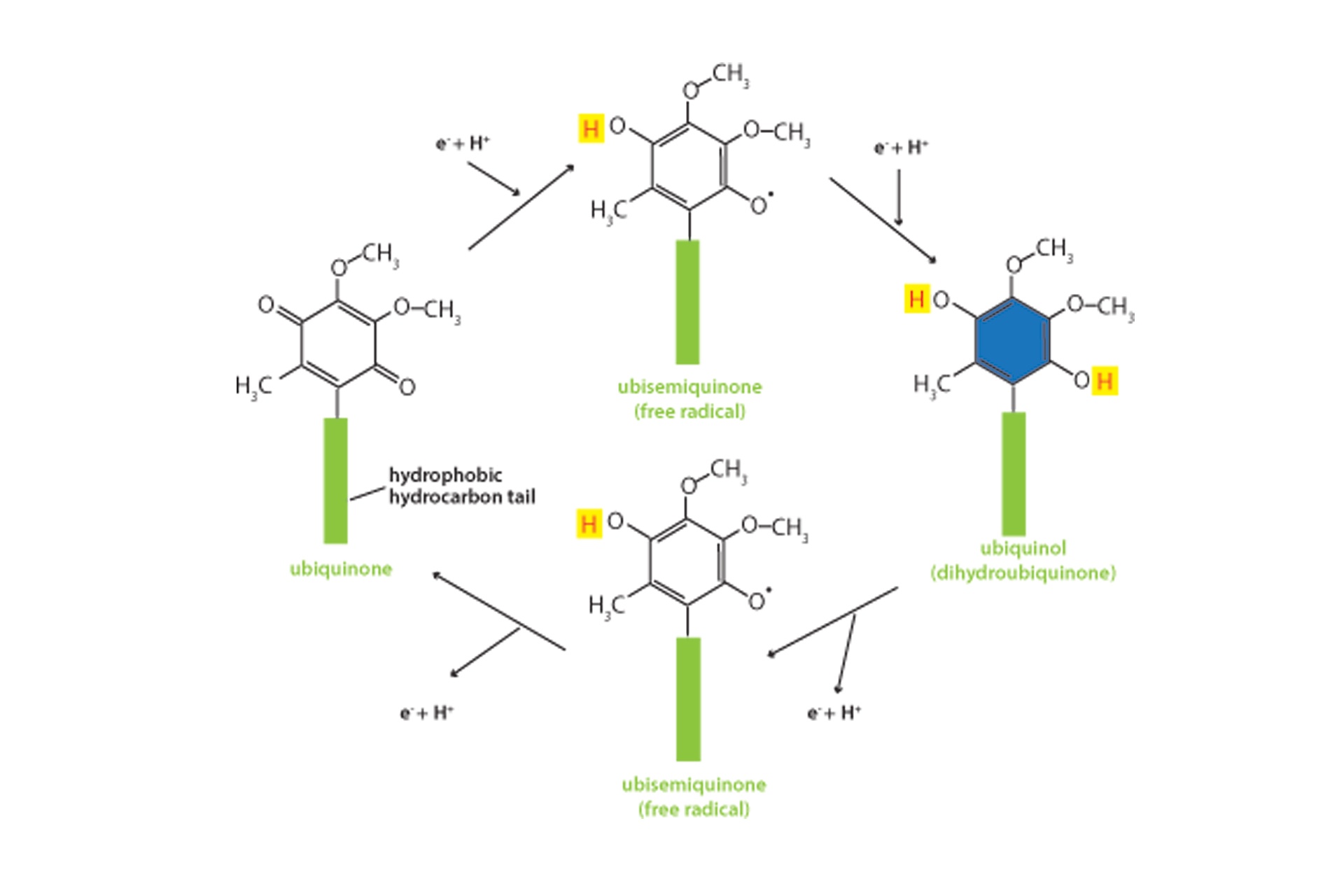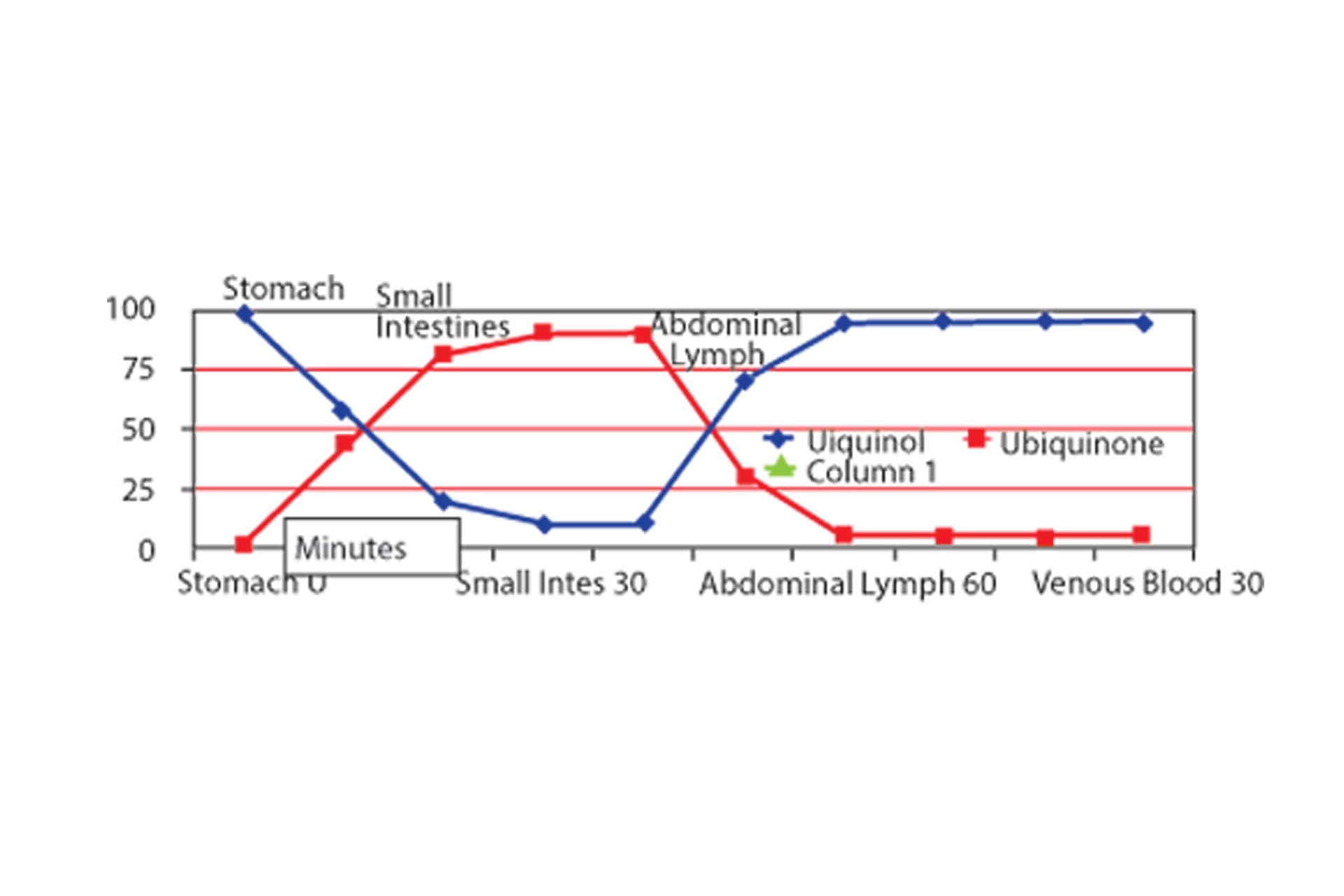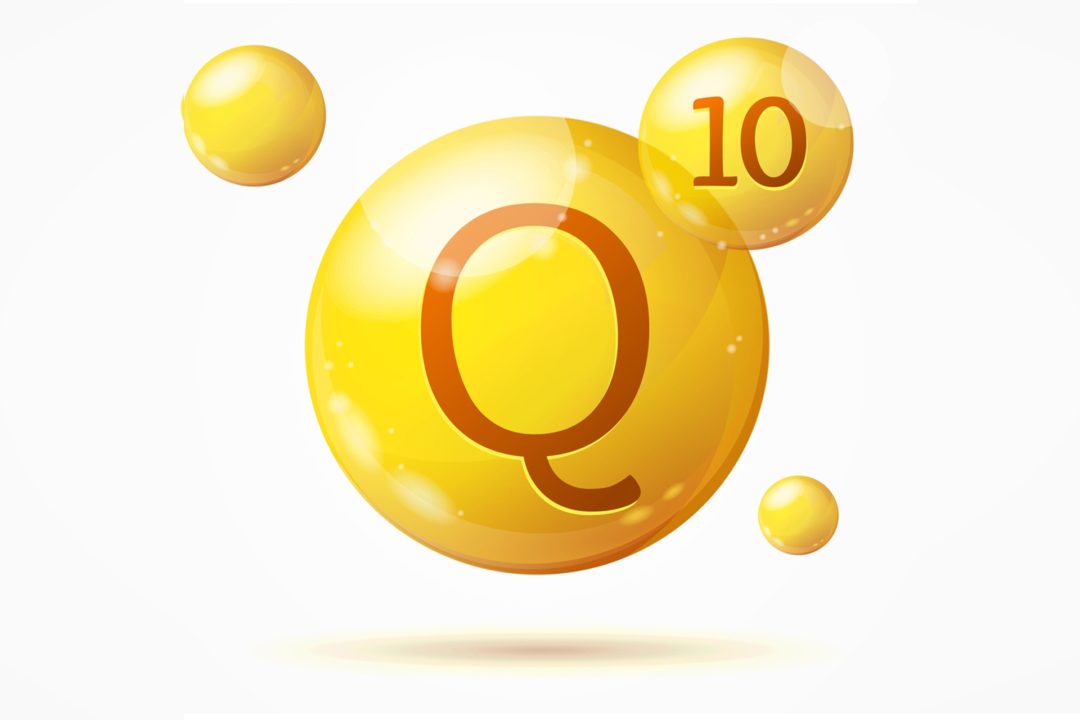Long-time Coenzyme Q10 researcher, Dr. William “Bill” Judy has recently published a book that details many of the health benefits of all forms of Coenzyme Q10 and addresses several misconceptions about Coenzyme Q10 supplements (14). Dr. Judy points out that many people mistakenly believe that ubiquinol (the reduced form of Coenzyme Q10) form is always better absorbed than the Ubiquinone (the redox starting form of Coenzyme Q10) form. Recent clinical studies show that either form can be absorbed better than the other, depending on the other ingredients in the supplement. What one should know about a Coenzyme Q10 supplement are 1) how many milligrams are absorbed, and 2) what is the cost per absorbed milligram.
Marketing terms such as “better absorbed” should be questioned unless the absorption or bioavailability is actually stated. Only when the actual absorption has been verified can the better absorbed product be determined.
Dr. Judy’s book, “The Substance that Powers Life: Coenzyme Q10, An Insider’s Guide,” is fascinating reading and offers me an excuse to chat with him about new research with Coenzyme Q-10. We haven’t discussed this important supplement for a few years in this column, so it’s time to see what’s new and important. We have discussed Coenzyme Q10 with several leading researchers in this column including Dr. Fred Crane (Coenzyme Q10 discoverer), Dr. Emile Bliznakov (author of The Miracle Nutrient: Coenzyme Q10), Dr. Stephen Sinatra (author of The Coenzyme Q10 Phenomenon), Dr. Gian Paolo Littarru (former president of the International Coenzyme Q10 Association), and Dr. William Judy (long-time Coenzyme Q10 co-researcher with Dr. Karl Folkers, the “father” of Coenzyme Q10) (1-8). The most recent discussion of the basics of Coenzyme Q10 was in 2007 with Drs. Crane, Littarru, Sinatra, and Judy.
In this column, we will discuss the function and health benefits of Coenzyme Q10, the absorption process of both ubiquinone and ubiquinol forms of Coenzyme Q10 and the fact that ubiquinol can oxidize to ubiquinone while in the pill and in the stomach before it can be absorbed. In Part 2, we will discuss the absorption of various forms of Coenzyme Q10, and in Part 3, we will discuss the latest clinical research with Coenzyme Q10. In this column, we will also discuss other interesting Coenzyme Q10 facts with Dr. William Judy including the following:
The term “Coenzyme Q10” refers to either one of the two equally important “redox partner” compounds that rapidly cycle back and forth within nanoseconds to exchange protons and electrons. (Please see Figure 1.) Coenzyme Q10 functions as an electron and proton carrier in the electron transport chain in the mitochondria in every cell of the body to produce energy (except in the red blood cells). This action has resulted in Coenzyme Q10 often being called “the spark of life.” More scientifically, this process has also been called aerobic respiration, aerobic metabolism, oxidative metabolism, cell respiration and electron transport system through the years.

In so doing, the oxidized form of Coenzyme Q10, which is called ubiquinone, is first converted into the free radical ubisemiquinone, and then to the reduced form of Coenzyme Q10, which is called ubiquinol. Each compound in the coenzyme Q10 cycle is active, critical and equally important. The interconversions are made within nanoseconds. The reduced form, ubiquinol, is oxidized to ubiquinone in the stomach and gut before it is absorbed. ubiquinol may be the starting material in a supplement, but the body absorbs it mostly as ubiquinone because the gastric system oxidizes ubiquinol to ubiquinone before absorption. Many ubiquinol (white) supplements oxidize to ubiquinone (yellow) within the capsule while still in the bottle. Cut open a capsule and look at the color of the slurry.
The body cannot absorb a crystal. Crystalline compounds must be dissolved to single molecules before absorption. The original Coenzyme Q10 supplement was powdered crystalline ubiquinone, which is poorly absorbed and should not be used as a comparison for absorption of modern Coenzyme Q10 supplements.
Ubiquinone is synthesized (manufactured from other compounds) within the body, but ubiquinol is not. The body converts (not manufactures) ubiquinone into ubiquinol as needed.
In absorption cells, lymph and blood, ubiquinone (oxidized Coenzyme Q10) is converted to ubiquinol, the reduced form of Coenzyme Q10. Circulating Coenzyme Q10 in the blood is 90–95% in the reduced (ubiquinol) form.
Recent clinical studies include the Q-Symbio and KiSel-10 Studies. Plus Professor Guillermo Lopez-Lluch’s comparative absorption study showing that a good ubiquinone Coenzyme Q10 product is absorbed better than a good ubiquinol product. The KiSel-10 Study is a fascinating study because the significant health benefits keep increasing for more than a decade even after the supplementation period was over.
William V. Judy, Ph.D., earned a Ph.D. in physiology and bio-physics from West Virginia University in 1971. Dr. Judy taught physiology for many years in the Indiana University College of Medicine, and he has been doing research on the absorption and effects of Coenzyme Q10 for 46 years. His initial work was in collaboration with Dr. Karl Folkers, University of Texas, whom he collaborated with for more than 27 years. He was one of the first researchers to run long-term clinical trials, spanning 30 years or longer, on hundreds of cardiac patients, many of whom had been “left to die” by the medical establishment.
This influence of Coenzyme Q10 on survival in congestive heart disease is shown in Figure 2.

Dr. Judy is the co-author of six medical textbooks (Physiology and Biophysics). His latest book on Coenzyme Q10, “The Substance that Powers Life: Coenzyme Q10, An Insider’s Guide,” was published near the end of 2018. Dr. Judy’s research findings have been presented in six scientific reviews on coenzyme Q10. His research group has done over 80 single-dose coenzyme Q10 absorption and bioavailability studies in the past 40 years.
Dr. Judy has been an expert witness on six lawsuits relative to CoQ10. The last lawsuit was between a USA and a Swiss company.
Dr. Judy is currently the chairman of the Southeastern Institute for Biomedical Research (SIBR), Inc., a clinical research support center for the pharmaceutical and natural products industries. SIBR Inc. is a contract research center that conducts clinical trials on natural products for the international community. Dr. Judy has traveled the world, lecturing to physicians, health care professionals and scientists about the benefits of Coenzyme Q10 in health maintenance and disease prevention.
Passwater: Dr. Judy, what’s new in the world of Coenzyme Q10 research since we last talked?
Judy: Since we last did an interview in 2007, several important findings have emerged from research. Besides my own research on Coenzyme Q10 absorption and bioavailability, I have attended the three International Coenzyme Q10 Association conferences; Kobe, Japan (2007), University in Bologna, Italy (2015) and Columbia University in New York City (2018). Each presented important new findings. Also, I have been working on a recently released book, “The Substance that Powers Life: Coenzyme Q10, An Insider’s Guide” (9).
Passwater: That’s a lot of science to cover. Can you give us a brief update on the role of Coenzyme Q10 in health and disease?
Judy: The basic role of Coenzyme Q10 is in energy production within the energy factories of cells called the mitochondria. This process leads to the production of the energy storage molecule, adenine triphosphate (ATP). Coenzyme Q10 also has antioxidant properties, and some of its effects may be related to a gene induction mechanism. These properties give rise to its clinical benefits. In a 2010 update of clinical uses of Coenzyme Q10, Drs. Gian Paolo Littarru and Luca Tiano point out that cardiovascular disease is still the main field of study of Coenzyme Q10, and the latest findings confirm a role of Coenzyme Q10 in improving endothelial function (the health and functioning of the artery linings) (10). They summarize that “In cardiac patients, plasma Coenzyme Q10 is an independent predictor of mortality.”
Studies on Coenzyme Q10 and physical exercise have confirmed its effect in improving subjective fatigue sensation and physical performance and in opposing exercise-related damage. In the field of mitochondrial myopathies, primary Coenzyme Q10 deficiencies have been identified, involving different genes of the Coenzyme Q10 biosynthetic pathway; some of these conditions were found to be highly responsive to Coenzyme Q10 administration. The initial observations of Coenzyme Q10 effects in Parkinson’s and Huntington’s diseases have been extended to Friedreich’s ataxia, where Coenzyme Q10 and other quinones have been tested. Coenzyme Q10 is presently being used in a large Phase III trial in Parkinson’s disease. Coenzyme Q10 has been found to improve sperm count and motility on asthenozoospermia. Moreover, for the first time, Coenzyme Q10 was found to decrease the incidence of preeclampsia in pregnancy. The ability of CoQ10 to mitigate headache symptoms in adults was also verified in pediatric and adolescent populations.”
Another interesting article of importance because it discusses the comparative absorption of ubiquinone and ubiquinol is by Drs. Enno Christian Kurt Freye and Hans Peter Strobel of the University of Düsseldorf in Germany (11).
Passwater: How does Coenzyme Q10 help produce energy?
Judy: Ubiquinone and ubiquinol, being redox pairs, are readily converted from one form to the other in the body. For example, when exogenous ubiquinone is absorbed in the intestines, it is converted to ubiquinol in the absorption cells, the lymph, or the blood. Since Coenzyme Q10 is not used to produce energy in the lymph system or blood, it is understandable why this conversion takes place to fulfill the need for antioxidant protection in the circulation. On the other hand, in the inner membrane of the mitochondria where energy is made, the oxidized form of Coenzyme Q10 (ubiquinone) is in great demand. Here the reduced ubiquinol form is rapidly converted to the oxidized ubiquinone form. In the mitochondria, this conversion creates a Coenzyme Q10 Cycle. Coenzyme Q10 can be intra-converted from the reduced to the oxidized form and vice versa in the body within nanoseconds as needed.
Passwater: Your book addresses some misinformation about Coenzyme Q-10 supplements.
Judy: Yes, I am concerned about statements I see on the Web, such as the ubiquinol form of Coenzyme Q-10 is ALWAYS better absorbed than the ubiquinone form. Clinical studies show that this is not so and either form can be better absorbed than the other, depending on the entire composition of the supplement and its method of preparation.
Also, I am concerned about the misconception out there that ubiquinol is better absorbed than ubiquinone by people over the age of 40. This is impossible since ubiquinol is oxidized to ubiquinone by the gastric juices. A third misconception that bothers me is that ubiquinol is the “active” form of Coenzyme Q10. There is just not any solid scientific documentation for these misconceptions.
Passwater: Well, the latter two are simply basic chemistry. Of course, a reduced compound such as ubiquinol will oxidize in an oxidative environment such as gastric fluid, and of course, both forms of a Redox pair are equally important. Let’s discuss the verifiable data—such as published peer-reviewed comparative absorption data on both forms—shortly, but I want to add that the scientific community prefers to do clinical studies with the ubiquinone form of Coenzyme Q10. Essentially all of the peer-reviewed clinical studies published in major medical journals are done with ubiquinone.
Judy: Coenzyme Q10 is a redox molecule. Its oxidized form, called ubiquinone, is essential to produce the energy storage compound adenine triphosphate (ATP) in the mitochondria of cells. Its reduced form, called ubiquinol, is important as a fat-soluble antioxidant. But there is no need to take a ubiquinol supplement in order to get enough ubiquinol in the blood plasma and in the lipoproteins in the blood.
Dr. Roland Stocker showed that back in 1992 (12). He and Dr. Detlef Mohr and Dr. Vincent W. Bowry showed that long-term supplementation with 300 mg/day of ubiquinone Coenzyme Q10 increases the ubiquinol concentration in the plasma and in the LDL lipoproteins by a factor of four.
Passwater: Both ubiquinone and ubiquinol supplements can increase the amount of ubiquinol in the blood because, as you said earlier, because both are present as ubiquinone in the gut and then are converted to ubiquinol in the plasma and lipoproteins. Coenzyme Q10 is kept in the ubiquinol form in the blood. Energy production is not done in the blood, so the body has no need for the ubiquinone form there. Instead, we need antioxidant protection in the blood.
Judy: That’s how I see it. The body will take care of converting the Coenzyme Q10 to the form that it needs. In the energy-demanding cells like the heart muscle cells, the Coenzyme Q10 will be in the ubiquinone form, the essential form for ATP energy production in the cells. In the blood, the Coenzyme Q10 will be primarily in the ubiquinol form.
Passwater: Isn’t the ubiquinol form unstable and difficult to work with?
Judy: Yes, ubiquinol is very unstable, very difficult to work with. We have found that the Ubiquinol molecule is very unstable in air, water and the gastric juice. As I said, it is oxidized to ubiquinone in the gastric juice before it is absorbed. (Please see Figure 3.)

We have done lab studies that show us that the ubiquinol in many ubiquinol supplements has already oxidized to the ubiquinone form of coenzyme Q10 inside the capsules. We have found that most ubiquinol products sold in the USA have 20–50% of its ubiquinol oxidized to ubiquinone within the softgel capsule. (Please see Table 1.) This is of no problem because the gastric juice would oxidize most of it to ubiquinone anyway.

Some Coenzyme Q10 supplements do contain added antioxidants to reduce this oxidation. Our lab studies and large dog studies show that oral ubiquinol, exposed to gastric juices in an artificial stomach or in a dog’s stomach and duodenum, will be mostly oxidized to the ubiquinone form of Coenzyme Q10 prior to the absorption of the Coenzyme Q10. Then the ubiquinone enters the absorption cell and is absorbed and converted back to ubiquinol in the lymph. This would be true even if the starting compound in the capsule was ubiquinone!
The Coenzyme Q10 then enters the venous blood as 94 to 96% Ubiquinol regardless if the starting material was Ubiquinone or Ubiquinol.
Passwater: Haven’t you tried to point that out several times?
Judy: Yes, for example, at the 2015 Bologna conference, I presented my lab studies showing the instability of ubiquinol and the conversion to the ubiquinone form prior to absorption in the jejunum. I also explained that the Coenzyme Q10 that gets absorbed in the ubiquinone form is then converted back to ubiquinol as it passes into and through the lymph on its way to the blood.
Passwater: That was in 2015. Is there a citation for it for our readers to read?
Judy: Yes, please see Reference No. 13.
Passwater: In summary for this part, Coenzyme Q10, in either form, is a very important health supplement. Let’s discuss how much is needed for optimal health in Part 2 and look at the recent clinical studies in Part 3.References
- Passwater, R.A. The Coenzyme Q-10 Breakthrough Part 1: The Untold Story. An interview with Dr. William V. Judy Whole Foods (January 2002). http://www.drpasswater.com/nutrition_library/Coenzyme%20Q-10%20Breakthrough.htm
- Passwater, R.A., The Coenzyme Q-I0 Breakthrough: Part 2: Repression of CoQ Heart Failure Research. An Interview with Dr. William V. Judy. Whole Foods (Feb 2002) http://www.drpasswater.com/nutrition_library/coenzyme_qi0_breakthrough_part_2.htm
- Passwater, R.A. The Coenzyme Q-10 Breakthrough Part 3: CoQ and Cancer. An Interview with Dr. William Judy. Whole Foods (Mar 2002) http://www.drpasswater.com/nutrition_library/coenzyme_q3.htm
- Passwater, R.A. Solving Biochemistry’s Biggest Mystery: How We Produce Energy. Part 1: The discovery of coenzyme Q-10. An interview with Dr. Fred L. Crane. Whole Foods (August 2002). http://www.drpasswater.com/nutrition_library/Crane_1.html
- Passwater, R.A. How Coenzyme Q-10 Works. Part 2: CoQ and Energy Production. An Interview with Dr. Fred L. Crane. Whole Foods (September 2002). http://www.drpasswater.com/nutrition_library/Crane_2.html
- Passwater, R.A. Coenzyme Q-10 and the Immune System, Aging and Cancer: A Unified Biomedical Concept. An interview with Emile G. Bliznakov, M.D. Whole Foods (Jan 2003)
- Passwater, R.A. Coenzyme Q-10: An interview with Emile G. Bliznakov, M.D. Part 2: Don’t take cholesterol-lowering drugs unless you also take coenzyme Q-10. Whole Foods (Feb 2003) http://www.drpasswater.com/nutrition_library/bliznakov_md.htm
- Passwater, R.A. Back to the Coenzyme Q-10 Basics: Part 1. An Interview with Drs. Drs. Fred Crane, Gian Paolo Littarru, Stephen Sinatra and William Judy. Whole Foods (June 2007) http://www.drpasswater.com/nutrition_library/Q-10%20Basics.htm.
- Judy, William V., Ph.D. The Substance that Powers Life: Coenzyme Q10, An Insider’s Guide. (Forlaget Ny Videnskab, 2018). ISBN 978-87-7776-186-7.
- Littarru, G.P. and Tiano, L. Clinical aspects of coenzyme Q10: an update. Nutrition. 2010 Mar;26(3):250-4. doi: 10.1016/j.nut.2009.08.008. Epub 2009 Nov 22.
- Freye, E.C.K. and Strobel, H.P. “The Whole Truth About Coenzyme Q10 You May Not find Elsewhere.”, Advances in Complementary & Alternative Medicine. 2:2 (2018).
- Mohr D, Bowry VW, Stocker R. Dietary supplementation with coenzyme Q10 results in increased levels of ubiquinol-10 within circulating lipoproteins and increased resistance of human low-density lipoprotein to the initiation of lipid peroxidation. Biochim Biophys Acta. 1992 Jun 26;1126(3):247-54.
- Judy, W. V. Coenzyme Q10 absorption research. Paper presented at the 8th conference of The International Coenzyme Q10 Association, Bologna, Italy. (2015, Oct. 11).










